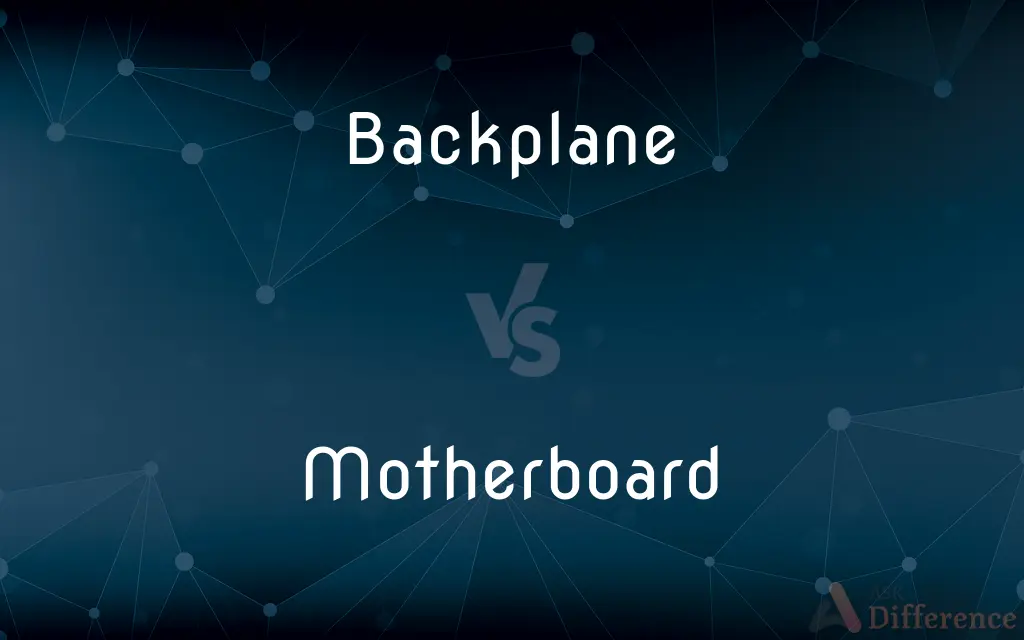Backplane vs. Motherboard — What's the Difference?
By Tayyaba Rehman & Maham Liaqat — Updated on April 2, 2024
A backplane provides a simple pass-through for signals between different components, focusing on connectivity, whereas a motherboard is a complex circuit board hosting and interconnecting all major computer components.

Difference Between Backplane and Motherboard
Table of Contents
ADVERTISEMENT
Key Differences
A backplane is essentially a circuit board with connectors and slots that allow various components, like expansion cards, to be connected to each other. It primarily serves as a physical and electrical backbone, facilitating communication between different parts without processing capabilities. On the other hand, a motherboard is a more complex entity that not only provides the physical base for components to be attached but also includes the processing units, memory slots, and other critical system components that enable the computer to function.
The backplane's design is focused on scalability and flexibility, allowing for easy addition or removal of components in systems like servers or industrial computers. This design simplicity supports high customization and easy maintenance. Whereas, the motherboard integrates a wide array of functionalities and components, including the CPU, RAM, and storage interfaces, making it the central hub of computing activity but less flexible in terms of scalability compared to backplanes.
In terms of functionality, backplanes are passive boards; they do not perform any processing but provide electrical connections between devices. Motherboards, however, are active components of a computer system, housing the CPU, memory, and other critical processing elements, thereby actively participating in data processing and system management.
Backplanes are commonly found in environments where a high degree of modularity and replaceability is required, such as in server farms, telecommunications, and military applications. Motherboards are ubiquitous in personal computers, laptops, and other consumer electronics, where the integration of components onto a single board allows for more compact and cost-effective designs.
Comparison Chart
Function
Provides connectivity between components
Hosts and interconnects computer components
ADVERTISEMENT
Design Focus
Scalability and flexibility
Integration of components
Processing Capability
None (passive)
Active (hosts CPU, RAM, etc.)
Typical Use
Servers, industrial computers
Personal computers, laptops
Scalability
High (easy to add/remove components)
Lower (due to integrated design)
Compare with Definitions
Backplane
Designed for easy scalability.
The modular backplane supported various expansions without needing a new board.
Motherboard
Ubiquitous in computing devices.
Every personal computer contains a motherboard that coordinates all functions.
Backplane
Lacks processing capabilities.
Despite its complexity, the backplane does not process data itself.
Motherboard
Limited scalability.
The laptop's compact motherboard offered limited options for upgrades.
Backplane
Focused on connectivity.
The backplane's design was optimized for signal integrity across multiple connections.
Motherboard
The primary circuit board of a computer.
The motherboard housed the CPU, RAM, and other critical components.
Backplane
A circuit board for connecting various components.
The server's backplane allowed for ten additional hard drives.
Motherboard
Central to computer operations.
A fault in the motherboard can render the entire computer inoperative.
Backplane
Used in specialized systems.
The telecom switch's backplane facilitated high-speed data transfer between cards.
Motherboard
Integrates multiple functionalities.
Modern motherboards include Wi-Fi, sound, and graphics capabilities.
Backplane
A backplane (or "backplane system") is a group of electrical connectors in parallel with each other, so that each pin of each connector is linked to the same relative pin of all the other connectors, forming a computer bus. It is used as a backbone to connect several printed circuit boards together to make up a complete computer system.
Motherboard
A motherboard (also called mainboard, main circuit board, or mobo) is the main printed circuit board (PCB) in general-purpose computers and other expandable systems. It holds and allows communication between many of the crucial electronic components of a system, such as the central processing unit (CPU) and memory, and provides connectors for other peripherals.
Backplane
(electronics) A circuit board that connects several connectors in parallel to each other, so that each pin of each connector is linked to the same relative pin of all the other connectors, forming a computer bus.
Motherboard
A printed circuit board containing the principal components of a computer or other device, with connectors for other circuit boards to be slotted into.
Motherboard
The main printed circuit board in a complex electronic device, such as a personal computer, usually containing the central processing unit, the main system memory, and other components essential to the device's operation.
Motherboard
(computer hardware) The primary circuit board of a personal computer, containing the circuitry for the central processing unit, keyboard, mouse and monitor, together with slots for other devices.
Motherboard
The board containing the main circuits of an electronic device, especially computers. The term is used primarily in microcomputer literature, where it designates the board containing the main expansion bus, and usually also the cpu. On motherboards designed with an expansion bus, often all of the circuits not contained on an expansion card are on the motherboard.
Common Curiosities
Is it possible to upgrade a backplane?
Yes, backplanes are designed for easy upgrades, allowing for the addition or replacement of components without redesigning the entire system.
What is the primary function of a backplane?
The primary function of a backplane is to provide connectivity between different components within a system.
How does a motherboard differ from a backplane?
A motherboard differs from a backplane in that it not only connects but also hosts critical components like the CPU and RAM, actively participating in processing.
Why are motherboards more common in personal computers?
Motherboards are more common in personal computers because they integrate all necessary components into a single, efficient, and cost-effective unit.
What is an example of a motherboard’s active role in a computer?
An example of a motherboard’s active role is processing data, facilitated by hosting the system’s CPU and memory.
What are the limitations of a motherboard in a laptop?
In a laptop, the motherboard’s limitations include restricted space for components, which limits upgrade options and scalability.
Can a system work with just a backplane?
A system cannot operate with just a backplane; it requires active components such as processors, which are typically found on a motherboard or connected boards.
Can a device have both a backplane and a motherboard?
Yes, in some complex systems, a device may have both a backplane for expansion purposes and a motherboard for processing.
What role do backplanes play in distributed computing?
Backplanes facilitate distributed computing by connecting multiple independent systems or boards, enhancing flexibility and scalability.
What makes motherboards limited in terms of scalability?
Motherboards are limited in scalability due to their integrated design, which binds many components together, restricting easy replacement or expansion.
Why is a motherboard considered the central hub of a computer?
A motherboard is considered the central hub because it integrates and controls all the critical components and functions of a computer.
Where would you typically find a backplane being used?
Backplanes are typically used in servers, industrial computers, and other environments that require high modularity and expandability.
How does the design of a backplane affect system maintenance?
The design of a backplane affects system maintenance by simplifying the process, allowing for easy replacement or upgrade of components.
How do motherboards contribute to the compact design of modern electronics?
Motherboards contribute to compact design by integrating various components into one board, reducing the need for multiple separate boards.
How does the flexibility of a backplane benefit server farms?
The flexibility of a backplane benefits server farms by allowing easy expansion and customization to meet varying data processing needs.
Share Your Discovery

Previous Comparison
Flashlight vs. Torchlight
Next Comparison
Arras vs. CurtainAuthor Spotlight
Written by
Tayyaba RehmanTayyaba Rehman is a distinguished writer, currently serving as a primary contributor to askdifference.com. As a researcher in semantics and etymology, Tayyaba's passion for the complexity of languages and their distinctions has found a perfect home on the platform. Tayyaba delves into the intricacies of language, distinguishing between commonly confused words and phrases, thereby providing clarity for readers worldwide.
Co-written by
Maham Liaqat















































